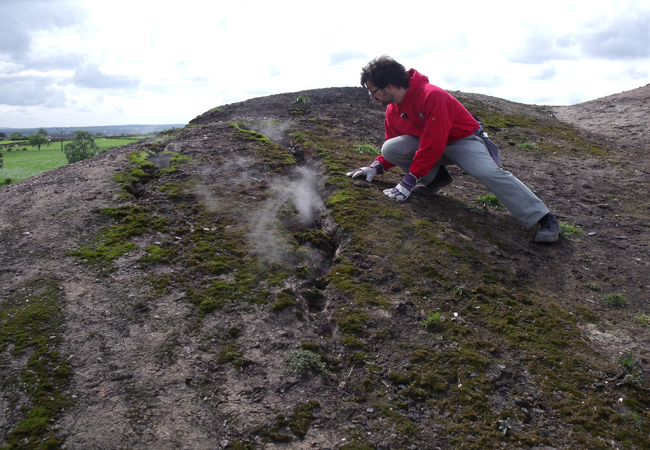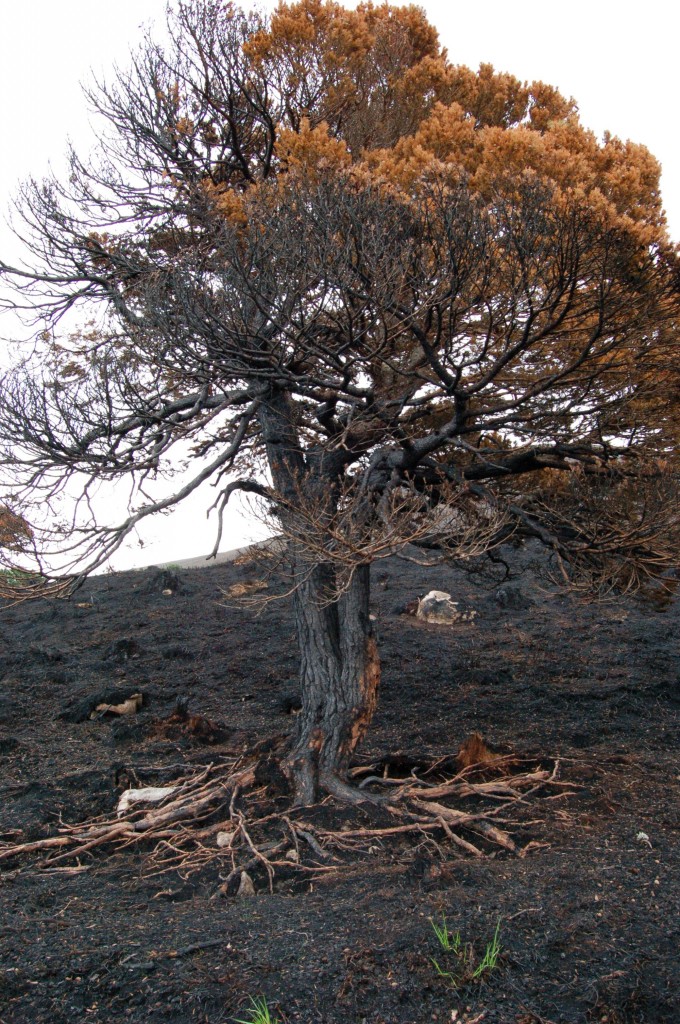This week, we are excited to introduce a new monthly blog column called GeoTalk, featuring short interviews with geoscientists about their research. To kick-start this regular Q&A series, we talked to Dr Guillermo Rein of Imperial College London about “the largest fires on Earth” and how they can contribute to greenhouse gas emissions.

Dr Rein next to a water vapour vent on top of the 30m-high Bogside bing, near Glasgow, Scotland. This bing is a man-made hill of mining waste, and started to smoulder in 2009, approximately 80 years after the closure of the pit. The spread of the combustion is accompanied by the development of vents ahead of the front. (Image by Dr Ricky Carvel and Dr Guillermo Rein, distributed under a CC BY-SA Creative Commons licence)
First, could you introduce yourself and let us know a bit about your research topic(s)?
I was born in Madrid, and studied engineering at ICAI (Ingeniero Industrial 1999). I then moved to the University of California at Berkeley to study combustion science where I got an MSc (2003) and PhD (2005), both in Mechanical Engineering. After six years at the University of Edinburgh, I am now a Senior Lecturer at Imperial College London. I research on fire dynamics, both in the built and the natural environments. At the EGU General Assembly, I usually talk at the Soil System Sciences sessions about my work on smouldering wildfires of peat and coal, which I claim are the largest fires on Earth. As a scientist and engineer, I want to understand these fires so that I can then solve the problems they pose.
A particular interesting area of your research is that of smouldering fires and related burning of fossil fuels. To start, could you explain to us what the difference is between smouldering fires and the more familiar flaming fires?
In wildfires, there are two types of combustion, smouldering and flaming, and depending on what is burning one dominates over the other. Pyrolysis of biomass always takes place due to the heat released by the wildfire, and it leads to the formation of two chemical products: pyrolysate (gas) and char (solid). In flames, the fuel oxidising is the gaseous pyrolysate so the reaction is airborne. In smouldering, the fuel is the char and the reaction is on the pores of the biomass, not airborne but on the solid itself (thus on the ground and under the ground as well). Smouldering is slow, low-temperature, flameless, and represents the most persistent type of combustion phenomena (easier to ignite and more difficult to suppress than flaming).
My true expertise is smouldering combustion, a rare topic, really. There are very few people who work on that but this might change in the incoming decade. I have coined the term “accidental burning of fossil fuels” referring to the wide spread of smouldering megafires of ancient carbon stored in natural coal and peat deposits, and burning for decades in six continents. It is a rather novel topic quickly attracting scientific attention.
On a video on your website you mention a smouldering fire that has been burning for the last 6,000 years. How is this possible, and how could such fires be extinguished?
That is a talk I gave at UC Berkeley. I always mention the case of the Burning Mountain, Australia. It is remarkable. It is a large coal seam partially exposed to the atmosphere and partially underground. It is now a National Park that one can visit, and it is also a sacred ground for natives. There are very few papers in the scientific literature where it has been studied. One of them from 1974 roughly estimated that, given the current burning rate and the burnt pattern left behind, it had been burning for six millennia. I always add at this point that at least the British cannot be blamed for it.
It is very difficult to suppress large smouldering fires like this one because it requires total flooding, fuel removal, or smothering. You can imagine that flooding or removing a massive portion of soil in a remote location is not always viable or desirable. Smothering is often attempted but it requires very long holding times (several years of continuous application) and is prone to sealing failures. However, more advanced techniques can be developed in the near future by combining technologies already used in seismic and petroleum engineering.
Is it possible to reduce the atmospheric carbon emissions related to smouldering fires? If so, how?
The problem with smouldering fires is that peat and coal are made of ancient carbon stored in the soil. This massive amount of carbon is slowly released to the atmosphere during fires creating pollution, haze episodes, and climate change. Moreover, it destroys accidentally valuable energy and ecological resources without any benefit to anyone whatsoever. The best way to avoid this is prevention: avoid smouldering fires from igniting to begin with (mainly via keeping organic soils moist, avoiding drainage, and keeping ignition sources away). When prevention fails, monitoring and suppression are the next tasks. But current monitoring and suppression technologies for smouldering fires are costly, rudimentary and rather inefficient. We need something better, and advanced science can feed and develop the needed technology.
Last but not the least, can you tell us a bit about your future research plans?
My research aim in the long term is to develop detection, monitoring and suppression technologies. Current knowhow comes 90% from flaming wildfires and unfortunately it does not work well for smouldering. However, before that happens, the science that allows us to understand these fires and provides a larger framework of knowledge must be developed first. My immediate plans are to contribute to this framework. With my team, I study peat and coal fires in the laboratory and in the field, including the chemistry of smouldering, the required ignition conditions, the spread patterns, the emissions, and so on.
One of my most pressing current objectives is to convince the scientific community that smouldering creates a positive feedback mechanism to climate change. This is because warmer organic soils and moisture deficiency create and accelerate smouldering hotspots, thus leading to the burning of more ancient carbon, closing the loop when the climate warms up and dries more organic soils. The theory and laboratory results are clear. I am now working on a paper putting everything together.

A lone tree destroyed by the 2006 Rothiemurchus peat fire in Scotland, UK. The trunk and lower branches have been charred by flames but the soil has been destroyed by a smouldering fire, exposing the trees roots and ultimately leading to the death of the tree. (Image by Dr Guillermo Rein and Dr Claire Belcher, distributed by EGU under a Creative Commons licence.)

Pingback: GeoLog | This calls for a celebration: GeoLog’s 1000 post!
Guillermo Rein
Speaking of which… Two ongoing peat fires have hit the news this week in North America: one in Ontario [1], the other in Michigan [2]. Stay tuned, they probably will last until the winter, if not longer.
[1] “Bog fire smoke choking people, animals”
[2] “These Wildfires May Never Really Leave; They Just Go Underground To Flame Up Anytime” http://www.ibtimes.com/articles/370384/20120804/michigan-duck-lake-fire-burns-underground-tahquamenon.htm#.UB2dqurVGHw.twitter